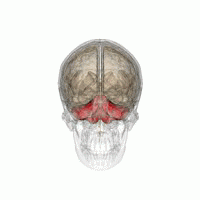The cerebellum is best known for its role in muscle coordination, but what part does it play in cognition and behaviour? Last month, I attended the 6th International Congress of the Society for Cerebellar Research (SRC 2014) where I found there is a lot more to the cerebellum than regulating motor movements…

What is the cerebellum?
The cerebellum (Latin for ‘little brain’) has the appearance of a separate structure to the brain and is located underneath the large mass of the cerebral cortex. Despite being relatively small in size, the cerebellum contains more neurons than any other region of the brain, owing to its unique geometrical structure and large number of tiny granule cells.
The cerebellum and motor control
Traditionally viewed as a coordinator of autonomic and somatic motor functions, we know that the cerebellum is essential to the coordination, precision and timing of movements. It works by processing sensory input from the spinal cord and other parts of the brain and integrating to fine tune motor activity.
Indeed, the most noticeable symptoms of cerebellar dysfunction are motor related, collectively referred to as ataxia. Overlooked for many years, it was clear at the conference that the field of cerebellar ataxias is now evolving as a well-defined neuroscience and clinical discipline in its own right.
Mario Manto, Editor-in-Chief of The Cerebellum (official journal of the SRC), highlighted that numerous case descriptions and case series on the ataxias remain unpublished, despite their importance for clinical care, basic research and personalized medicine. In an effort to address this, Mario explained the rationale for the new sister journal, Cerebellum & Ataxias, in providing a home for these reports for the benefit of the research community and, most importantly, the patients themselves.
Beyond the control of movements, the conference showcased a number of exciting advances into the contribution of the cerebellum to motor learning. Laura Rondi-Reig talked us through how the cerebellum processes sensory information required to ‘fuel’ the navigation circuit, drawing on her current work to understand the neural basis of navigation and spatial memory.
Maria Leggio presented the cerebellum as the ‘predictive brain’, proposing a sequence detection model as a potential explanation for cerebellar predictive processes. Leggio noted that the involvement of the cerebellum in predictive control processes for motor learning is still unclear. Interestingly, the hypothesis that detecting and generating sequences is central to our understanding of basic cerebellar function in different domains, including the cognitive domain, appears to remain an area of much debate.
Our understanding of cerebellar function has changed dramatically over recent years. As reflected in the focus of the conference, cerebellar processing is now widely considered to be involved in cognition and emotion. In fact, the cerebellum maps to cerebral association networks in such a highly ordered manner that it mirrors the asymmetries of the cerebral cortex for language and attention.
The cerebellum and cognition
As a particular highlight of the conference, Jeremy Schmahmann focused on cerebellar cognitive affective syndrome (CCAS), a condition that follows from lesions to the cerebellum, involving deficits in the cognitive domains of spatial cognition, affect, executive function and language. The syndrome was first described by Schmahmann and his colleagues in 1998, and has paved the way for a growing body of evidence to support the concept of ‘cerebellar neurocognition’.
Tremendous progress has been made in this area with insights from neuroanatomical investigations, functional neuroimaging studies and in-depth neuropsychological assessment of patients with cerebellar disorders. In his talk, Schmahmann referred to the cerebellum as a modulator of neurological function, with implications in many conditions, such as schizophrenia and autism. It was concluded that the ultimate aim now is for the bedside clinical diagnosis of neuropsychiatric conditions to include a cerebellum component.
Along the same theme, Peter Mariën gave an overview of the mounting evidence implicating the cerebellum in language, shedding light on its link with an array of different language deficits, ranging from apraxia of speech to ‘foreign accent’ syndrome.
Final thoughts…
These were just some of the highlights from the conference, which focused on a number of other aspects of the cerebellum, including cerebellar development, cellular and synaptic mechanisms, non-invasive cerebellar stimulation, cerebellar networks, cerebellar pathologies and clinical trials.
Dedicated in memory of Ferdinando Rossi, the conference provided a unique and friendly atmosphere in which to exchange the latest scientific advances in cerebellum research. It was evident hat, with the convergence of molecular discoveries, clinical observations and new approaches in the field, there is still much to learn from the study of the cerebellum, with far-reaching implications to the diagnosis and treatment of many neurological conditions. I look forward to next year’s conference in Brussels!
Liz Bal
Latest posts by Liz Bal (see all)
- Why neuroscience needs neuroinformatics: a Q+A with Helena Ledmyr - 15th March 2016
- How can we advance data sharing in dementia research? - 9th October 2015
- Podcast: Understanding the links between sex/gender and autism - 26th May 2015
COGNITIVE ROLE OF CEREBELLUM RECOGNIZED AT LAST !
International Conference at last recognizes the importance of the cerebellum in neuroscience, psychiatry and psychology.
For more details on role of cerebellum see:
https://www.academia.edu/4680271/The_cognitive_cerebellum_A_big_role_in_psychology_for_the_little_brain
What with the other part is called little brain